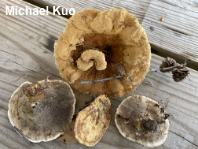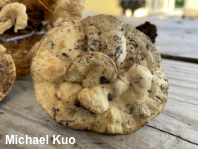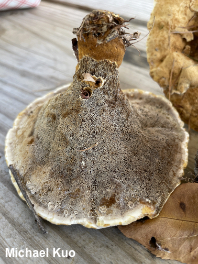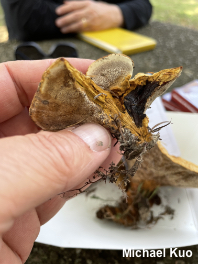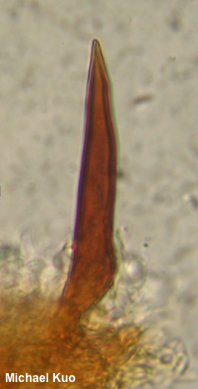| Major Groups > Polypores > Onnia tomentosa |

|
Onnia tomentosa [ Basidiomycota > Hymenochaetales > Hymenochaetaceae > Onnia . . . ] by Michael Kuo Vaguely reminiscent of a faded Phaeolus schweinitzii, this usually-terrestrial polypore features a velvety, dull, yellow-brown cap and stem, a grayish to brownish pore surface, and brownish yellow flesh that turns black with KOH. Under the microscope, Onnia tomentosa has beautiful, long, straight setae, which helps to separate it from several similar species with curved, or "hooked," setae. Onnia tomentosa is usually associated with the roots of spruce trees. A similar species in eastern North America is the recently named Onnia subtriqueta, which is primarily associated with pines, rather than spruces (based on study—Ji et al. 2017—of five collections) and which features curved setae. Onnia leporina is a larger, usually stem-less species that usually inhabits the wood of spruces; it also features curved setae. Inonotus tomentosus and Pelloporus tomentosus are synonyms. Description: Ecology: Saprobic on the buried roots or wood of conifers—primarily that of spruces, but occasionally on the wood of pines; causing a white rot; annual; usually growing alone or gregariously on the ground (but attached to roots of trees); summer and fall (or over winter in warm climates); originally described from Sweden; widely distributed in Europe, Asia, and North America. The illustrated and described collection is from Pennsylvania. Cap: 5–12 cm across; more or less round in outline; usually convex to planoconvex; dry; velvety; dull brownish yellow to yellow-brown; at maturity often darker centrally; bruising brown; not zoned—or with vague, poorly defined zones of color. Pore Surface: Pale grayish, becoming brown; bruising brown when young and gray; with angular pores 1–3 mm across at maturity; tubes to 5 mm deep. Stem: 3–4 cm long; 1.5–2.5 cm thick; equal, or slightly club-shaped; dry; covered with yellow-brown to brown tomentum. Flesh: Dark brownish yellow; tough and stringy; faintly zoned. Odor: Not distinctive. Chemical Reactions: KOH red, then quickly black on flesh and cap surface. Microscopic Features: Spores not observed in the collection described; described by Gilbertson & Ryvarden (1986) as 5–6 x 3–4 µm, ellipsoid, smooth, hyaline in KOH, and inamyloid. Hymenial setae abundant; 65–100 x 5–12.5 µm; fusiform; straight or with a small basal curve; thick-walled; smooth; reddish brown in KOH. Setal hyphae absent. Hyphal system monomitic; hyphae thin- to thick-walled, 2–6 µm wide, smooth; hyaline to brown-walled; clamp connections not found. REFERENCES: (E. M. Fries, 1821) P. Karsten, 1889. (Overholts, 1953; Smith, Smith & Weber, 1981; Arora, 1986; Breitenbach & Kränzlin, 1986; Gilbertson & Ryvarden, 1986; Phillips, 1991/2005; Dai & Niemelä, 1997; Barron, 1999; Wagner & Fischer, 2002; Roody, 2003; Larsson et al., 2006; McNeil, 2006; Trudell & Ammirati, 2009; Valenzuela et al., 2013; Ginns, 2017; Ji et al., 2017; Læssøe & Petersen, 2019; Kibby, 2020.) Herb. Kuo 09182102. This website contains no information about the edibility or toxicity of mushrooms. |
© MushroomExpert.Com |
|
Cite this page as: Kuo, M. (2022, February). Onnia tomentosa. Retrieved from the MushroomExpert.Com Web site: http://www.mushroomexpert.com/onnia_tomentosa.html |
